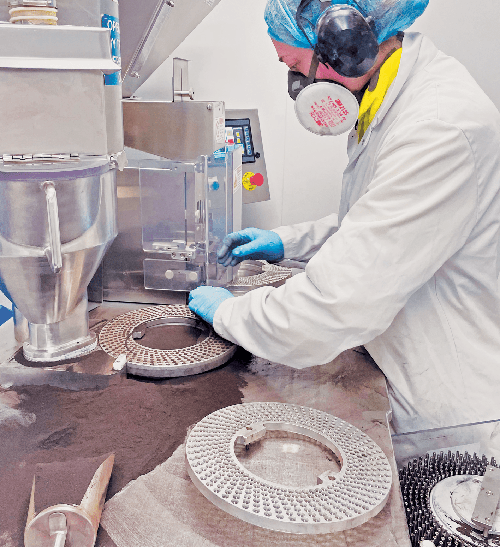Emma Verkaik, CEO of BCMPA – The Association for Contract Manufacturing, Packing, Fulfilment and Logistics — discusses the latest trends with members and how outsourcing suppliers are bringing innovative solutions to market
The convenience of single-serve sachets is already well established and this popular packaging format is now driving significant growth in the nutraceutical industry, especially in the on-the-go market.
The surge is primarily attributed to a heightened awareness of hydration and electrolyte supplementation, which is no longer confined to athletes but has expanded to the wider public in the use of newly marketed nutraceutical products.
As well as convenience, precision dosing is also essential for these types of supplements and single-serve sachets, particularly stickpack versions, meet this demand.
James Allan, Director of The Oxford Health Company (TOHC), explains: “These sachets have gained immense popularity owing to their convenience, portability and precision in terms of dosage, making them ideal for today’s fast-paced lifestyle.”
For further convenience and greater branding opportunities, the stickpacks are often placed in containers such as tubs, pouches or cartons.
“The focus on single-serve sachets is not just a response to market trends,” says Scott Stripp, Head of Business Development and Supply Chain for Rain Nutrience: “It’s a strategic approach to enhance user convenience and product freshness, while also being mindful of environmental impacts.”
“Single-serve sachets address the modern consumer’s desire for portability and ease of use while also opening new avenues in product design and marketing. It's a trend that's reshaping how we think about product delivery and customer engagement.”
Innovative packaging and subscription models take off
New packaging formats are also supporting the growth in subscription models. As part of its direct-to-consumer (DTC) offering, Rain Nutrience is leveraging the growth in this area.
Stripp observes: “DTC subscription enables rapid scalability and caters to the increasingly growing demand for bespoke solutions that align with specific nutritional needs at various life stages.”

Adapting subscription models to the current economic climate and consumer behaviours is noteworthy. Many BCMPA members are innovating by offering different packaging for initial and repeat orders.
For example, many first orders will be sent in a more high-end container, such as glass, with repeat orders coming in pouches, tubes or other easy-to-post packaging; these then get decanted into the container supplied with the initial order.
This encourages sustainability and enhances cost-effectiveness, catering to the growing consumer demand for ecofriendly options without compromising on quality or the user experience.
BCMPA member Wasdell is being proactive with these packaging developments. The business has introduced nested blisters for postal packs, which allow for more compact and efficient distribution.
This is particularly advantageous for online sales, wherein ease of shipping plays a crucial role. Additionally, the introduction of thin, postal-friendly bottles is a response to the growing demand for convenience and sustainability.
Andy Causer, Director of Sales at Wasdell, notes that these shifts are about more than looks: “Innovative packaging is not just about aesthetics; it’s about practicality, sustainability and enhancing the user experience.”
Embracing sustainability in packaging
The emphasis on sustainability throughout all industries reflects the broader global trend towards much greater environmental responsibility. Companies are increasingly adopting ecofriendly packaging and using it as a key differentiator.
More than half of TOHC’s packaging is now made from biobased polylactic acid (PLA), a material derived from renewable resources such as sugar cane.
Allan reflects on this significant shift and holistic approach: “Transitioning to bio-PLA was a challenge but also a necessity. We had to adapt quickly to meet our sustainability goals and respond to the growing consumer demand for ecofriendly products.”

“It’s about considering every component of our packaging, from the labels and inks to the adhesives, to ensure that our entire packaging process aligns with our sustainability ethos.”
Power Health is also navigating the demand for sustainable packaging: “Although pouches are popular for their practicality, there’s a notable shift towards options such as glass packaging,” says the company’s Managing Director Vicky McIver.
“We’ve also recently moved to using formats such as cardboard tubes and vegetable print ink for labels; more customers and end users expect every aspect of their product to be as environmentally friendly as possible.”
The company recently invested £4 million in a new factory to help drive more sustainable practices and earn vital certifications.
“This new facility is not just an expansion; it’s a step towards more accreditations, better processes and a reflection of our commitment to quality and sustainability,” says McIver.
“This allowed us to obtain good manufacturing practice (GMP) certification from the Medicines and Healthcare products Regulatory Agency (MHRA) for herbal product manufacturing.”
Mushroom products and beyond: the constant search for the new superfood
Although new pack formats/materials and the need for sustainability are ongoing packaging trends, the use of mushroom derivatives in nutraceuticals is becoming ever more popular from an ingredient perspective.
Mushrooms are being incorporated into a wide range of health products thanks to their perceived benefits in terms of providing immune support, stress reduction and cognitive enhancement.
This growing interest is fuelled by both traditional uses and modern research, making mushrooms a key ingredient in the evolving landscape of health and wellness products.
Producing high-quality mushroom supplements is no small feat. “It involves the careful consideration of multiple factors such as the extraction method, whether it be water or alcohol-based, and the part of the mushroom used,” Allan details.
“There are also different growth mediums, such as sawdust, which significantly impact the quality and cost of the final product.”
Additionally, the sourcing of such niche ingredients has forced manufacturers to broaden their searches. “We prioritise UK suppliers but, of course, we extend globally when necessary,” explains McIver.

“We find coffee drinks and capsules are the most popular products for mushrooms. And, naturally, with any new nutraceutical product, you must conduct trials to be sure everything is safe and fit for purpose.”
“We operate in a space in which trends can shift rapidly, much like fashion. Influencers are increasingly shaping what consumers want, which in turn guides our product development and sourcing strategies.”
Children’s vitamin demand booming
Third-party outsourcing partners are also seeing a boom in the child vitamins sector, which is being driven by growing consumer awareness and demand for cleaner, more targeted supplements.
This trend speaks to the rising concern among parents regarding the purity and efficacy of vitamins intended for their children.
“Parents are increasingly looking for appealing and healthy supplement options for their kids,” shares Causer. “This has led to a surge in the development of child-friendly nutraceuticals, particularly in forms that are both effective and enticing to younger consumers.”
One of the key challenges in this sector is the incorporation of natural sweeteners and bulking agents while ensuring the highest standards of food safety.
The production process for children’s vitamins demands heightened sensitivity and precision, considering the vulnerable demographic they cater to.
“Parents today are more informed and selective about what they give their children,” says Stripp. “They're looking for vitamins that are not just effective but also safe and free from unnecessary additives."
"The evolution in consumer behaviour towards health and wellness has catalysed a shift in our product development. There’s a growing demand for bespoke solutions — especially in the child and women’s health sector. It’s a challenging but necessary balance for manufacturers to strike.”
The market for children's vitamins currently sees a division between tablets and gummies. Although tablets are often considered to be “cleaner” owing to fewer additives, gummies are the more popular form.
They are more palatable for children older than five, despite sometimes being less clean in terms of ingredients. For younger children, the focus is more on powders and flavoured liquids, which are easier for them to consume.
This presents a unique challenge for manufacturers: balancing the health benefits with the product’s appeal to its young consumers.
Pet care focus
It’s not just humans that nutraceutical products now focus on. Another trend is the transformative phase that pet care products are experiencing. More recently, this has been marked by an influx of cost-effective items that rival premium brands in quality.
The popularity of these products showcases how the increasing value placed on pet health mirrors human dietary preferences and nutritional needs.
One of the most significant developments in this space is the growing inclination towards human-grade ingredients in pet products. This shift assures pet owners of the quality of the supplements. The formulations, albeit distinct in their specifics, draw parallels in quality and nutritional value.
“Pet owners are demanding higher quality, often seeking products with human-grade ingredients for their pets,” Stripp says.
“It’s a clear indicator that pet owners have a desire to provide their pets with the best possible wellness care and recognises that, just as for humans, there is no one-size-fit all solution for companion animals.”
“The pet care segment is growing rapidly, with a strong emphasis on tailored nutrition for different breeds and life stages,” notes Causer. “For instance, specific vitamins such as calcium, vitamin C and vitamin D are formulated to cater to the unique requirements of various breeds.”
Wasdell is also responding to this trend by focusing on popular product forms such as powders and capsules containing powder, which are preferred for their ease of administration and dosage accuracy.
Meeting nutraceutical trends
From innovative product formats such as single-serve sachets and mushroom supplements to a strong commitment to sustainable practices, BCMPA members are adapting and responding to market developments and consumer preferences.
As the nutraceutical sector continues to navigate these emerging trends, finding reliable outsourcing partners becomes increasingly pivotal for both emerging and established brands.
The expertise and resources offered by the BCMPA enables brands to excel in a competitive landscape, making it the first option to finding a nutraceutical outsourcing partner.
With thanks to Power Health, Rain Nutrience, The Oxford Health Company and Wasdell.




